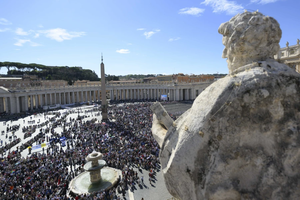Our Lord Feeds the 5,000 One Person at a Time
When you go to Mass or the adoration chapel, Jesus is there for you.

The story is set in the time of Christ, and it starts with a little boy who’s around 10 years old. His mom asks him to run an errand, and she reminds him to bring his food because he’s going to be gone awhile. He rolls his eyes because she’s just being mom and of course he isn’t going to forget his food. He runs the errand and on his way back he realizes that he forgot his food. He feels embarrassed and annoyed with himself, but he’s hungry and has a long walk home. He trudges along in the kind of hopelessness that is appropriate for the setup of a story.
On his way home, he sees a huge crowd of people. He’s curious, so he goes over to see what’s happening. It’s nothing that’s of any interest to kids — just a man talking and a lot of people listening. It’s hard to hear him. The boy is about to continue his hungry walk home when the man who was speaking catches his eye. In that moment of eye contact, the boy realizes that this man knows that he’s hungry, and that he’s embarrassed about being hungry. (This is the part of the story I especially don’t want to write, because words never do justice to this kind of knowing.) Then, what was that? That man who was talking to the crowd — he seemed to smile and say that he would take care of things, but in a way that only this boy would understand. No one else notices.
Curiosity piqued, the boy decides to remain.
The man giving the talk turns to the men with him, and another little boy hands them a basket of bread and there is a conversation, and then the men accompanying the speaker fan out through the crowd instructing everyone to sit down in groups. The man raises his eyes to heaven, blesses the bread, breaks it, and gives it to the other men, who then give it to all the people.
This is, of course, the Multiplication of the Loaves, and the man is Jesus. But there’s something important about the boy’s perspective. Everyone in the crowd is talking about a miracle — surely there wasn’t enough food for everyone, and yet everyone is eating! Everyone is amazed at what just happened because it was obviously a miracle. But our protagonist has a profound interior experience — he knows that this all happened because of him.
The boy eats ravenously and then turns it over in his mind as he walks home.
I don’t know why I thought that an unnamed 10-year-old boy would be relatable, but I want my readers to see themselves in him because it seems that this mix of public and private is how God relates to us. The multiplication of the loaves is an enormously important story, showing Jesus’ love for us and his generosity, for both our physical and spiritual needs. He gave them bread for their bellies, miraculous bread that points toward the Eucharist, bread for our souls. The Eucharist is obviously important to our faith; it is the centerpiece of the Mass, our most important and very public liturgical event.
None of that precludes the personal, private, individual experience that this little boy had. Hidden in this extraordinary event that’s deeply meaningful for the Church’s understanding of God and the sacraments is God’s extraordinary love for this little boy. This miracle was deeply meaningful for him, personally, in a way that it wasn’t for anyone else. Everyone in the Church can recall the love and generosity that Jesus showed when multiplying the loaves as it relates to the Eucharist; this little boy can recall that day he was hungry because of his own forgetfulness and how Jesus did something extraordinary for him, secretly, hidden inside a very public event. This miracle is both.
There were thousands of people there, each with his own joys and sorrows and life stories, each with his own personal, hidden experience of the miracle. Likely, many of them were carrying heavy burdens, worries and stresses. Likely, too, many of them were happy about things a 10-year-old boy could never understand. They all spoke excitedly about the miracle of the plentiful loaves because that’s what they had words for and what they could comprehend readily; they all had hidden, personal experiences that they didn’t have words for and weren’t ready to share.
That is how Jesus meets us, too. When you go to Mass or the adoration chapel, Jesus is there for you. His presence in the Eucharist is extraordinary, and he is there for you, personally, in the midst of that. This is true of all of reality, which is all bound up in God’s Providence, but it is especially true of sacred reality like Scripture and the sacraments.
If I wrote thousands of other little vignettes about everyone else who ate miraculous bread, any individual would get lost in the sea. But this is the mystery of Jesus’ presence in the Eucharist, and no one is lost in the sea. He is not just present on the altar; he is present to you, personally, like he was to that little boy. Not every visit to Jesus becomes an event talked about for centuries and memorialized in art, but at every visit, he sees you, not lost in the sea of people but you, wherever you are in life right now, with whatever you’re carrying. In the very public celebration of Mass or in a crowded adoration chapel, we can find Jesus’ hidden, personal, extraordinary work in our lives.
What a gift.

















